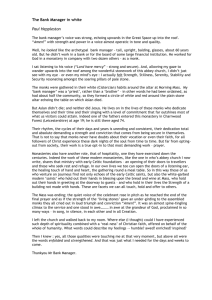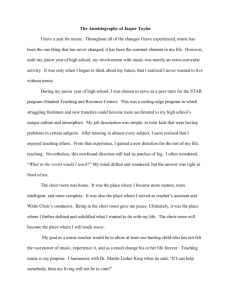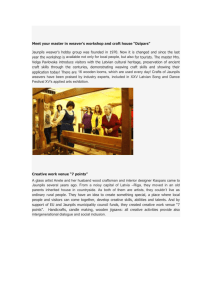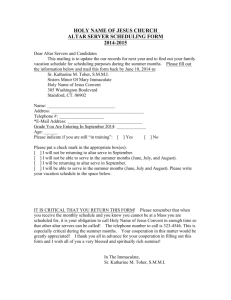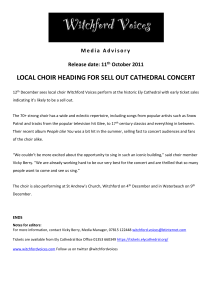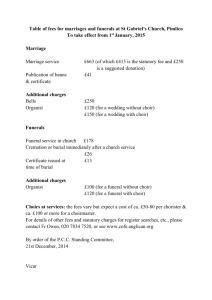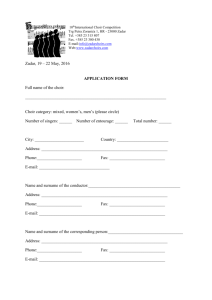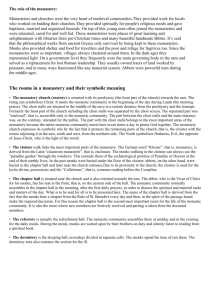information guide saint peter's church lo - Lo
advertisement
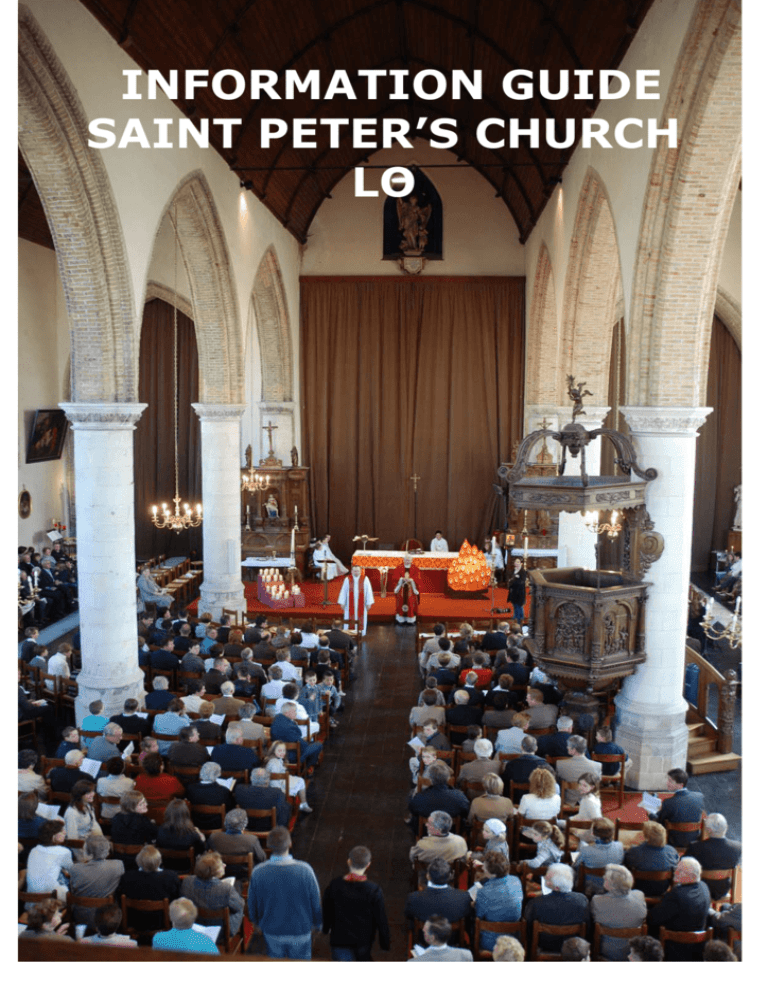
INFORMATION GUIDE SAINT PETER’S CHURCH LO Saint Peter’s church was built in the sober Gothic style. The oldest part, the priests’ choir, where the high altar is found, dates back to the 13th century. The east end (front of the church), between the transept and choir, was used as an abbey church by the Augustine monks of St. Peter’s abbey (circa 1093-1797). In this abbey church the nave served as “officie- koor” (office choir), where the daily prayers Were chanted. The northern aisle was used as the abbot’s chapel. The west end (back of the church) was used as the parish church. The building was plundered by the “Beggars” (Protestant army) in 1578 and destroyed by a fire in 1580. It was rebuilt in the same style during the first half of the 17th century. The French Revolution expelled the monks, and the whole building then became parish church. In the 19th century the abbey room, which blocked the entrance between the parish church and the abbot’s chapel, was pulled down (1847). Then the northern aisle of the west end was broadened by about 2 metres onto the grounds of the former monastic premises (circa 1860). At last the old Romanesque tower was replaced by a neo-gothic one (1866-1869). A recent catastrophe was the destruction of both tower and church in the war in 1915. After Word War I the church was rebuilt. Church furniture Because of the shortness of its name, Lo enjoys a certain fame in crossword puzzles; but much more the splendour of its church’s furniture and wood-carving justify a visit, especially to the church. Your visit being limited, we restrict our description to the church furniture and the wood-carving, casting but a short glance at the paintings. We start in the rear of the church. At the south side of the wood-loft (=organ-loft above) you can see the late renaissance “Broodbank” (bread pew), dating back to 1626 as the sign there indicates. As with virtually all furniture here it is made of oak. The angels between the panels represented as making music, remind of the former function as a partition-wall of the rood-loft, which probably used to stand in the abbot’s chapel. In 1704 the wooden panels were replaced by paintings that appropriately represent the seven works of mercy, as on this place, after funerals and annual masses, bread was distributed to the poor. The paintings suggest what the old church tower and garb of the monks (white) end the magistrates (black) looked like. The rail of the rood-loft (above) is remarkable because of the four little front and side panels, which are pearls of rococo art. They were taken out of the pulpit’s stairs after World War I; but in fact they used to be part of early 18th century communion rails. The bigger panels were made on the pattern of the small ones in 1936. The organ mechanism (1714) from the Ypers organ-builder Jacobus van den Eynde was destroyed during the World War I and replaced by a new one built by Jozef and Pieter Loncke. The organ-case is carried out in baroque style. The pulpit is a rare and fairly good example of late renaissance style, dating back to the first quarter of the 17th century. Originally it consisted of only the “tub” (balcony). Typical of the style is the decoration of the “tub” panels, each separated by Corinthian columns and closed by round arches. In these panels 6 carced bas-reliefs show scenes from Saint-Peter’s life. Also remarkable are the devils below, tied up as it were by God’s word. The foot and the sound-canopy are 19th century additions. The altar of Our Lady of consolation in the northern aisle is remarkable because about 1865 it was composed of fragments from the choir stalls, which we’ll soon the able to admire in the nave. These stalls are supposed to have been composed up to 1865 of two L-shaped wings. They probably were to be found between the communion rails and the east side of the crossing tower (central tower). About 1865, when the old crossing tower was torn down, the shorter sides were removed. Several parts were incorporated in the altar of Our Lady of Consolation. The small niche in the altar retable was probably once used to connect a shorter and a longer side. And at the right side of the retable a little panel was incorporated, on which the date 1624 is to be seen, referring to the origin of the stalls. On the north and south wall of the west end (back) seven paintings by the hand of the Furnes painter Vigor Boucquet, represent the seven sorrows of our Lady. They apparently date back to about 1660. In 1762 Rev. Bernard Calmeyn, who was both monk and parish priest of Lo, who obviously knew his parishioners well, presented the church with the confessional that is found in the northern aisle of the transept. The beautiful “rocailles” or shell motifs above are characteristic of the rococo era (Louis XV). Here too, we can admire the painting “Saint-John in the boiling oil” (right side) by an anonymous 17th century master, clearly influenced by Caravaggio’s style. For centuries the choir stalls in the nave of the east end were the central place of prayer, where the monks used to sing hymns in praise of god for many hours every day. The stalls are carried out in late renaissance style (1624). They are attributed to two groups of artists: to Ootgheer’s studio (Furnes) for the northern aisle and to the studio of Van de Velde (Ypers) for the southern aisle. After all the destruction mentioned earlier, a second drastic change was carried out in 1912. In order to have more room for funeral services, the two halves of the choir stalls, which were standing at both sides of the nave, were simply sawn into two parts. Thus were obtained the two parts of the choir stalls that now are standing in the “officiekoor”, as well as the two pieces without back-panels in the priests’ choir. In order to be changed into a confessional chair these back panels were transported to Ypers, where unfortunately they were destroyed in the course of World War I. But, thank God, sufficient beautiful parts of the stalls are left. Notice the sculptured heads at the misericords (monks’ stools) and at the partition between the seats of the northern part of the nave. Remarkable also are the ornaments upon the soundcanopy, each of which has its own ornamental or figurative motif. We find children’s heads, monsters, and coats of arms, Surrounded by real and imaginary kinds of plants an fruit. The baroque high altar is made of wood but its painting makes it look like marble. The central picture (1640) is a masterpiece by Jan Boeckhorst. It represents Christ at the cross between the two malefactors. The four panels (about 1680) at both sides of the priests’ choir are strikingly beautiful. They show a luxuriance of tendrils, flowers and fruit, a rich ornamentation, which is typically Baroque. At either side five angel-figures act as caryatids. To the left of the high altar in the abbot’s chapel, notice the altar of the rosary, of which the retable is especially conspicuous. It contains 15 bas-reliefs representing Our Lady’s mysteries. For a while they used to be part of the communion rails. This sculpture is one of the best examples of this genre in our province. The first left panel in the central row e.g. pictures Jesus amidst his sleeping disciples in the Olive-garden (Gethsemane). The whole surroundings, the hilly landscape and far away in the background the little gate where the first servant of the high-priests appears, beckoned to by Judas, enhance the atmosphere of the moment. The entire composition, full of diagonals, is mounted in an oval. At the southern side of the high altar a leaden case containing some bones of William of Lo is to be found in the wall beside the altar of Saint Roche. It was discovered in March 1770 during repairs carried out in the church floor. William was an illegitimate offspring in al line of counts and a mercenary in holy causes. After the murder of Charles the Good in 1127, the murderers’ partisans supported William in the struggle for the count’s coronet. Expelled from Flanders, he fled to England, where he became the first professional commander of medieval mercenaries. Blind and turned out of England about 1155, he returned to Flanders and died at Lo in January 1164 or 1165. He was the greatest benefactor of the abbey. By way of conclusion a curious little fact: among his contemporaries and even as late as 1770 he was reputed to be of gigantic stature. Calculations based upon the thigh-bone preserved here have shown that William had a body-length of 1m71 (5 feet 7 inches), not rally worthwhile mentioning in the in the Guinness book of Record!
